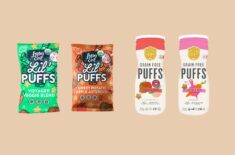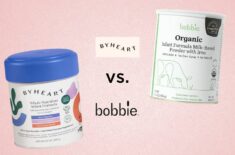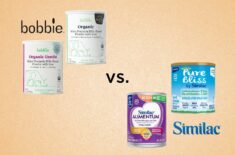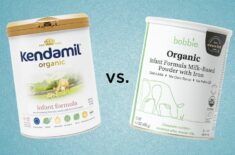Overview
Did you know that mango is dubbed the “king of fruits” in some parts of the world? It’s packed with high nutritional value and can be a fun first food for your little one.
Mangoes are healthy and easy to eat making them a good baby food option.
They’re loaded with vitamins and other immune-boosting nutrients like vitamin C and potassium that offer several health benefits such as better digestive health and improved immunity. (1)(2)
But is your baby ready to enjoy mangoes?
How can your baby eat mangoes in baby-led weaning?
Is it an allergen or a choking hazard?
We’ve answered these questions and more below.
What Is BLW?
Baby-led weaning (BLW) is an approach that lets your baby skip the traditional spoon-feeding puree and jump straight to appropriately sized-finger foods.
BLW lets your baby lead in feeding themselves, giving them more control over what and how much they eat.
Can Babies Eat Mango In Baby-Led Weaning?
Yes, they can! Your little one can enjoy a ripe mango from as young as six months.
This tropical fruit can be a great sweet treat for babies because it’s easy to serve and filled with disease-fighting nutrients like vitamin e and vitamin a.
However, as with all food introductions, it’s best to proceed with caution and supervise your baby as they eat because mangos are slippery to hold. (1)(2)
Top Reasons To Serve Mangos In BLW
Nutrition Facts
Mangoes are rich in the following nutrients:
- Polyphenols – These are plant-based compounds that function as antioxidants, which can help reduce inflammation. Mangos contain mangiferin, a powerful polyphenol that has been shown to lower the risk for diabetes, cancers, and other illnesses. It also helps support a healthy heart. (3)
- Immune-boosting nutrients – Mangoes are rich in vitamin C, vitamin A, vitamin E, folate, and potassium, which can help improve your baby’s immune system and aid in cell growth and repair. These may lower your baby’s risk of infection and help produce more white blood cells that fight off diseases. (1)(2)
- Beta-carotene and Lutein – This helps develop healthy eyes and a strong immune system. (1)(4)
- Folate and vitamin B6 – These nutrients can help your baby’s brain growth and development. (5)
- Digestive enzymes and dietary fiber– These compounds help protect your baby’s digestive health and can help reduce constipation and diarrhea. (6)
Are Mangoes A Good First Baby Food?
Yes, fresh mangoes make a great first food option for your baby. It can be given to your baby as soon as they start eating solid foods at around six months.
Some tips to consider:
- Serve soft, ripe mangoes and not green ones.
- Hard green mangoes can be a choking hazard for your baby and may cause digestive problems.
- You can try offering your baby small portions and watch out for any signs of adverse reactions or allergies like rashes, vomiting, or diarrhea.
Is Mango A Choking Hazard?
Yes, mangoes can be a choking hazard. It may not be among the top common choking hazards identified by AAP (American Academy of Pediatrics).
However, green, unripe mangoes can be hard to swallow for babies.
Even ripe mangoes can be slippery to hold, and their flesh is stringy to eat. These can still make them possible choking hazards for babies. (7)
To reduce the risk of choking, it’s better to offer mangoes that are ripe and soft.
You can slice the mango lengthwise like thin spears so your baby can hold it better. You can also mash mangoes, it’s easier to swallow.
Always supervise your baby while they’re eating.
Is Mango An Allergen?
Allergies with mango are rare and uncommon. However, some people develop skin rashes when they come in contact with the peel. (8)
Allergic reactions may occur immediately or days later. If your family has a history of allergy to mango or nuts, you must proceed with caution.
It’s best to seek the advice of a pediatrician or a dietitian before introducing this fruit if this is the case. (8)
Can I Give Mango Jam To My Baby?
It’s not recommended to give added sugar and salt to babies under two years old.
Jams are usually made by cooking fruits like mangoes with large amounts of sugar.
Exposing babies to too much sugar can result in several health problems like cardiovascular diseases and obesity later in life. (9)(10)
Instead of sugary jams you can offer fresh fruits in small portions and cut them into appropriate sizes.
If fresh mangos are not available, choose sugar-free options like frozen or canned mangoes packed in water or natural juices.
Try avoiding mangos in syrups because they may contain too much sugar for your baby.
When Can Babies Eat Mangoes?
Your baby can enjoy a ripe mango as soon as they start eating solid foods. The AAP (American Association of Pediatrics) recommends that babies explore solid foods other than breastmilk and formula starting at six months. However, many experts and pediatricians give the green light at four months. (11)
Each baby is unique and milestones are reached at their own pace. It may be best to know the signs of readiness: (11)
- Sits on their own
- Shows strong head and neck control
- Displays interest when you offer food, they open their mouth or attempt to grab
- Your baby is able to move their food from the front of the mouth to the back to swallow
- Your baby can swallow the food rather than spit it out
How Can I Give Mango To A 6-Month-Old Baby?
The best way you can offer mangoes to a six-month-old baby for the first time is by offering the pit. You can offer a whole mango pit with most of its flesh removed.
This reduces the risk of choking and allows your baby to get those motor skills moving.
If your baby has difficulty holding the pit, you can try coating it with shredded coconut.
You can also scoop the mango flesh in a bowl and add unsweetened yogurt for your baby to enjoy.
How To Introduce Mangoes In BLW?
Fresh mangoes are a safe and nutritious baby-led weaning food option.
Here are a few tips on how to introduce mangoes:
- It’s not advisable to offer unripe mangoes to babies. They’re too sour for babies, and they can be choking hazards because they’re hard to swallow.
- Soft ripe mangoes are more ideal food options. Choose mangoes that aren’t too ripe and slippery because they can be more difficult for babies to hold.
- Cut mangoes into strips as thick as your fingers.
3 Super-Quick & Easy Ways To Serve Mangoes In BLW
- Give them the pit – The easiest way to serve a mango is to offer its pit peeled and most of the flesh removed. Your baby can nibble the yummy fruit with less risk of choking.
- Mango Spears With Shredded Coconut – Cut mango lengthwise or in spears. Top or roll the spears in shredded coconut. This can help your baby properly hold the mango and prevent it from slipping.
- 10-Second Mango Puree – Scoop the mango flesh and put it in a blender or a food processor. Add a couple tablespoons of coconut yogurt and thoroughly blend until it is smooth.
Do You Have To Cook Mangoes For Babies?
Many baby food recipes include mangoes. When introducing mangoes to your babies, you don’t need to cook them if they’re ripe and soft.
Simply peel, cut, and serve. However, you can also steam your mangoes to help them break down a bit.
The cook time will vary depending on the ripeness of the mango.
How Do You Prepare Mangoes For Baby Led Weaning?
Choose Organic
Whenever possible, choose non-GMO (genetically modified organism) and organic mangos because they’re grown without pesticides, fertilizers, or fungicides. Babies can be vulnerable to foods that have been exposed to chemicals. Some studies reveal that GMO foods may cause some adverse effects to the pancreas, kidneys, liver, and reproductive system.They may even be linked to cancer. (12)
Washing Is Important
It’s important to thoroughly wash fruits and vegetables before serving them to your baby.
To wash mangoes:
- Rinse them under running water.
- Gently rub them to remove any soil or residue.
- Since rinsing with water isn’t enough to thoroughly clean fruits, you need to wash them with a veggie wash or soak in baking soda water.
- In a bowl, add 1 tsp of baking soda for every 2 cups of cold water.
- Submerge the mangos into the baking soda water and soak for 12 to 15 minutes.
- Wash them before cutting them open.
- Use a clean cloth to wipe the mangoes dry.
Use Frozen Mango If You Can’t Find Fresh In Stores
It’s perfectly fine to use frozen organic mango if fresh mango isn’t in season where you live.
You can defrost it and use it to make a quick purée or you can mash it and let your baby have a sensory play session.
How Do You Cut Mango For Baby-Led Weaning?
For 6-9 Months Old
- Peel and remove most of the flesh off the pit. Give your baby the mango pit to nibble or suck.
- Offering mango spears can also be a great way for babies to hold and enjoy a mango. Simply slice mangoes lengthwise. For babies to have a better grip, you can roll them on shredded coconut.
For 9-12 Months Old
- Mango pit or mango spears are still great options.
- But you can now offer more finger foods choices, especially if your baby has developed their pincer grasp, the ability to hold objects between their thumb and pointer finger.
- You can slice mangoes into bite-sized pieces.
For 12+ Months Old
- You can offer sliced mangoes that your baby can pierce using a fork. If they enjoy using a spoon, you can put diced mangoes in a bowl so they can easily scoop them.
- If your baby is still not comfortable with utensils, it’s okay. You can help your baby practice by demonstrating how it’s done.
How To Store Mango
Purées
Store mango purée in an airtight container and refrigerate for up to three days. You can also fill baby food freezer trays with purée and freeze.
Finger Foods
Mangoes that have been peeled and sliced can also be placed in an airtight container. It can stay in the refrigerator for up to three days or in the freezer for up to 8-12months. (13)
REFERENCES
- https://fdc.nal.usda.gov/fdc-app.html#/food-details/1102670/nutrients
- https://pubmed.ncbi.nlm.nih.gov/31963293/
- https://ift.onlinelibrary.wiley.com/doi/abs/10.1111/j.1541-4337.2008.00047.x
- https://pubmed.ncbi.nlm.nih.gov/28208784/
- https://www.ncbi.nlm.nih.gov/pmc/articles/PMC4772032/
- https://www.mayoclinic.org/healthy-lifestyle/nutrition-and-healthy-eating/in-depth/fiber/art-20043983
- https://publications.aap.org/pediatrics/article/125/3/601/72642/Prevention-of-Choking-Among-Children
- https://www.ncbi.nlm.nih.gov/pmc/articles/PMC3206236/
- https://www.ncbi.nlm.nih.gov/pmc/articles/PMC6520717/
- https://www.ncbi.nlm.nih.gov/pmc/articles/PMC8391470/
- https://www.mayoclinic.org/healthy-lifestyle/infant-and-toddler-health/in-depth/healthy-baby/art-20046200
- https://pubmed.ncbi.nlm.nih.gov/18989835/
- https://www.extension.purdue.edu/extmedia/HHS/HHS-785-W.pdf













